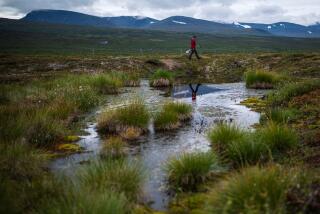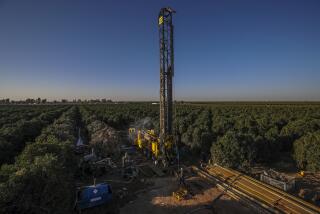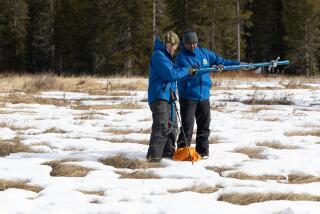Ice researchers capture catastrophic Greenland melt
Over a few summer days in 2012, nearly all of the Greenland ice sheet surface thawed right under the feet of a UCLA-led team of scientists.
What was not absorbed into snow quickly gathered and flowed across the 20,000-square-mile sheet, coalescing into roaring turquoise rivers. And then most of it disappeared.
------------
FOR THE RECORD
An earlier version of this post said coauthor Alberto E. Behar died Saturday. He died Friday.
------------
Where all that water went may seem an easy guess. But thatâs just the problem with Greenland ice science -- some of the guesses have been wrong, according to a study published online Monday in the journal Proceedings of the National Academy of Sciences.
A model that has assumed most meltwater hangs around the surface in large lakes is missing an important and complicated subplot and may overestimate sea level rise as a result. The study found that meltwater quickly moves from the surface to deep below the ice surface, and about of a quarter of it apparently lingers there, according to the study.
âThe entire surface is incredibly well drained,â said UCLA geographer Laurence C. Smith, lead author of the study. âItâs like water running off a shed. And thatâs at odds with most of the previous work thatâs been done on this subject.â
The finding not only could change the focus of scientists studying the surface of the ice sheet, it could also alter their calculations for how ice flows to the North Atlantic Ocean, where it contributes to a worldwide rise in sea level.
Research teams fanned out in the treacherous 5,328-square-kilometer watershed of the Isortoq River using a drone boat and floating GPS beacons, among other devices, as well as satellite imagery.
They chronicled the flow of 523 stream and river networks totaling about 3,600 miles, all of which feed the Isortoq River, which flows into the sea.
All of the surface channels ended in deep, unexplored holes in the ice, called moulins, where water cascaded into the depths of the ice sheet, the study found. So much water flowed that it was the equivalent of filling every lake, pond, stream and river in the drainage area every day or two, the study found. It was like getting an inch of rain a day, over many weeks, Smith said.
Some rivers abruptly disappeared while researchers were on the ice. Researchers tossed a GPS device into one roaring river, then checked to see if its data were transmitting, said Smith. The technician said he thought the transmitter had broken -- it indicated the beacon was stationary.
âWe got back in the helicopter and went around the bend,â Smith said. âA crack had opened and the river got swallowed up in the half-hour since we had set down. A moulin had opened up in 30 minutes and our big, long river got swallowed up, right around the corner.â
Since researchers canât follow the water in the miles-thick ice sheet, they measured the flow from its edge, at the Isortoq River. The volume did not match that of the meltwater. Less water was reaching the sea during the peak of the melt, the study suggests.
âOnce it goes down the moulins, not all of it is coming out,â Smith said. âThereâs a little bit less water coming out than the climate models predict.â
Where water goes once it disappears in these internal cataracts has been an abiding mystery.
âPeople have gone as far as throwing rubber ducks down the holes to see where the rubber ducks come out,â said Tom Wagner, cryosphere program manager for NASA, which funded the research. âAnd no one has ever found a rubber duck.â
Some water may linger in recently discovered aquifers inside the ice, one of which is estimated to be the size of West Virginia.
Regardless, a significant fraction is not coming out right away, the study found. During the peak of the rare melt event, the atmosphere-based model overpredicted the flow to the sea by a few fractions of a cubic kilometer a day. Nonetheless, by late summer, the model and actual outflow were about in sync, Smith said.
So, the model gets big melt events wrong, even if it is close to capturing the flow in the longer run.
âThat water isnât just going to stay; itâs going to start coming out eventually,â Smith said. âIt might have come out 18 months later. I canât envision the ice sheet absorbing that water for centuries.â
There are other immediate implications to the finding. If that much meltwater, which is warmer than the ice, rapidly reaches the ice sheet interior, it can change the way the ice deforms and flows. And ice flow toward the much warmer sea is a major factor in future sea level rise.
âThese are the kinds of things that we need to take into account as we go forward and we try to estimate the contribution of the Greenland ice sheet to sea level rise,â Wagner said. âRight now we have a pretty simplistic model for how it melts.â
Waleed Abdalati, a University of Colorado geographer and former NASA scientist who was not involved in the study, said the catastrophic flood event offered a laboratory for understanding the type of abrupt thaws that may be typical in the future.
Smith will return to examine the Isortoq River in February. âMaybe the missing water is actually draining out during the winter time,â he said. âIf you look at the climate models, they all say thereâs zero runoff leaving the ice sheet in the winter. They just shut down.â
Smith and Wagner noted that the bottom line on Greenland is that melting has been accelerating over a period of a decade or more, and that the melt line is moving higher and higher in elevation. All that fresh water ultimately will flow to the ocean, they said. The details on how it gets there are still being worked out, though.
The study also involved researchers from Rutgers University, the University of Wyoming, NASA-JPL, City College of New York, the University of Utah and the U.S. Army Cold Regions Research and Engineering Laboratory in Hanover, N.H., and the Earth Vision Trust, in Boulder, Colo.
The paper was dedicated to coauthor Alberto E. Behar of NASA-JPL and Arizona State University, who designed and helped deploy the drone used to capture water flows. He died Friday in an aviation accident near the Van Nuys Airport.
Follow me on Twitter: @LATsciguy







